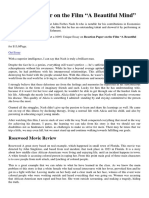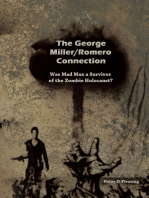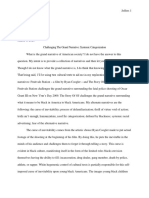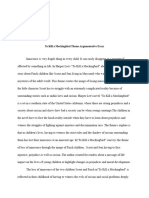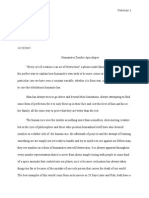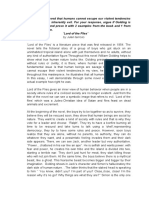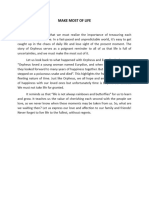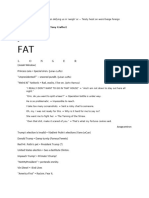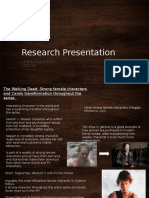ESSAY II: Hybrid Essay
ESSAY II: Hybrid Essay
Uploaded by
Carlos GomezCopyright:
Available Formats
ESSAY II: Hybrid Essay
ESSAY II: Hybrid Essay
Uploaded by
Carlos GomezOriginal Title
Copyright
Available Formats
Share this document
Did you find this document useful?
Is this content inappropriate?
Copyright:
Available Formats
ESSAY II: Hybrid Essay
ESSAY II: Hybrid Essay
Uploaded by
Carlos GomezCopyright:
Available Formats
Carlos O.
Gomez Lorie Hamalian English 115 11/11/2013
ESSAY II: Hybrid Essay
Horror films have been around as long as any other genre of film. Many find the horror genre repulsive and hard to stomach, but still a large group of moviegoers find chillers enjoyable. Americans say they enjoy horror films because they make your heart race and your body temperature drop. Horror films seduce stranded thrill seekers. Many, consciously, walk into dark movie theatres only to experience something uncanny and hair-raising. Thrill seekers say they are attracted to horror films because they can let their imagination run wild judgment free. You can imagine what you would do in a similarly frightening situation, and you can witness all the gore and violence society so carefully shuns. Most recently released horror films are said to be shallow. Many movie rating sites and film review blogs say todays horror films lack meaning and attain only simple and shortlived fright. Many agree, however that films like 28 Days Later come with a deeper meaning and have a lot to say about society and about humanity in general. Some would even go as far as to say that similar horror films reinforce common fears throughout American culture.
Judith Halbertstam argues, Horror, I have suggested, exercises power even as it incited pleasure and/or disgust. in her well-known essay Parasites and Perverts. Horror films can have a purpose besides entertainment. Horror gives writers the power to spark other emotions in readers and the same rules apply to film. Messages can be successfully read through stories of fear. 28 Days Later is a 2002 Sci-Fi/Horror film written by Alex Garland and directed by Danny Boyle. The movie takes place in the post-apocalyptic city of London where the Rage virus was born. The Rage virus can be spread through the exchange of an infected creatures blood or saliva. This virus turns humans into bloodthirsty zombies with only one motive, to kill. The movie follows and brings together five dissimilar characters that work towards an obviously common goal: survival. The main character, Jim, is a bicycle courier who snaps out of a coma only to find an empty city. Jim walks across this eerie and empty city only to find trouble in an infested church. He is saved by two masked strangers who take him to a zombie free subway station. Jim meets Mark and Selena and is informed about the happenings that led to the pandemic. Mark is later killed by Selena who swears she would kill Jim in a heartbeat if he was infected. Selena is made to be a strong, brave, and somewhat heartless woman. She makes it clear to Jim that Survival is as good as it gets. She is not interested in building a friendship with Jim and explains that she would not hesitate in killing him. This stubborn character is later introduced to Frank and Hannah, a father and daughter who have also survived the infestation. Frank and Hannah want to reach a safe home in the outskirts of the city after listening to a radio broadcast with
promises of a cure. Selena refuses to travel with the family because she believes they are weak and not worth their troubles. We can consider her mindset in the beginning of the film a monstrosity. This particular scene portrays Selena as a heartless and selfish character, but it can also be related to a similar selfishness within our own society. Most of us are taught to be selfish and to do whatever it takes to survive, like Selena. We are encouraged to pity those who are weaker or less privileged than we are but we are also encouraged to showboat success. Selena is selfishness disguised as a brave and fearless woman in the same way todays politicians are disguised by fake smiles and a fake sense of concern. One of the biggest monstrosities seen throughout the film is this selfishness that Selena eventually overcomes. It is the same monstrosity many of us witness on a daily basis. We live in a capitalistic society that encourages riches and power. We see it everywhere we go. Major companies ship jobs overseas and take advantage of the poor working conditions other countries maintain. We see interest groups funding political races every election season. Selfishness is seen in characters like Selena but the harm is real outside of this movie. Our children are taught to desire a life of riches and success. We are taught to follow trends and encouraged to buy the latest in technology. We are convinced to do all of this through acts of selfishness. Jim sees a priest in one of the very first scenes, when he walks into the church after waking up from a coma. The infected priest attacks Jim but he hesitates to kill him. At first I thought Jim had hesitated because he was in a world of confusion, but I only later realized that he had hesitated because the infected person was a priest. Jim was afraid of killing a once holy man because he felt he would be
condemned or punished. I am almost sure Jim would have gone straight to the point if it were anybody else attacking him the way the priest did. This particular scene says a lot about the nature of society. It shows how we are afraid of religious authority. I think we can agree and conclude that religion is glorified by American society. Our countrys religions promote common values and encourage members to live by very similar ideologies. Religion can, for that same reason, be harmful to those who are not affiliated with such religious groups. Religion is promoted in American society. We see it in our countries monetary system. We are bombarded with phrases like God bless America and are almost forced to memorize and recite a pledge of allegiance that again promotes religion. Religion, as ugly as it may sound, can be considered a monstrosity within American society. Religion can isolate people who live by different standards. This is something I thought about after watching my friends reaction to the scene. We all felt tainted and upset after watching it. I am sure my friends and I would have had a different reaction had the first zombie not been a priest.
The text in this image became a popular slogan associated with the film 28 Days Later. These ten simple words can be served as the main message of the film. The image makes me think about the movie as a whole and about the change in attitude with Selena and Jim. Jim survived the zombie apocalypse, but it cost him his humanity. He was pushed to the edge and became the person Selena was in the beginning of the movie. He was not at all hesitant to kill anybody that got in his way by the end of the film. Selena changed for the good. She was put to the test at the end of the movie when Jim comes up to her. She believed he was infected, but was not able to kill him in a heartbeat because she loved him. Selena realizes that survival is not indeed as good as it gets by the end of the film. She learns to love again, she learns to care for others, and most importantly she learns to be hopeful. 28 Days Later might not have had the biggest box office hit, but it did serve as food for thought. The film 28 Days Later brought a greater meaning alongside the zombie apocalypse. There are major ideas being discusses through this action packed chiller. Religion, politics, selfishness, and internal struggles were all expressed in this film. These strong ideas were all presented to us beneath my own fear of zombies. Jims, Hannahs, and Selenas experiences taught me a lot about myself and the society we live in. I learned to look past the nasty make up and special effects and pay attention to the struggles being thrown against the changing characters. Andy Cooper wrote: Humans often seem just as bad, and sometimes worst, than zombies, in his essay A Plague of Meaning . This quote restates my own idea that characters like Selena and Jim can be horrific, selfish, and nasty people. They can be horrific, selfish, and nasty the same way we can. The same way
American society allows us to become horrific, selfish, and nasty people. The film though, also ends on a happy note. There is hope for humanity at the end of the film. Just like there is always hope for humanity. The film is saying that we are always allowed to change. We only choose to stay selfish and we only choose to be bad people. We can always change, the way Selena changed. There is always hope.
Works Cited
28 Days Later. Wikipedia, the Free Encyclopedia. Wikipedia.org, 11 Nov. 2013. Web. 11 Nov. 2013
Hill Place. : Humanity and Hope in 28 Days Later HillPlace Blog, 9 Dec. 2012. Web. 11 Nov. 2013
Troperville. RSS. Tvropes.org, n.d Web. 13 Nov. 2013.
Halbertstam, Judith. Parasites and Perverts an Introduction to Gothic Monstrosity. Introduction. Parasites and Perverts: Anti-semetism and Sexuality in Nineteenth-century Gothic Fiction. N.p.: n.p., 1991. N.pag. Print
Blake, Brandy B., and Andrew Cooper. Monsters. Southlake, TX: Fountainhead, 2012. Print
You might also like
- British Horror: 28 Days Later (Danny Boyle, 2002)Document12 pagesBritish Horror: 28 Days Later (Danny Boyle, 2002)Laura RhowbothamNo ratings yet
- Critical PaperDocument11 pagesCritical Paperapi-360820094No ratings yet
- Reaction Paper On The Film "A Beautiful Mind"Document3 pagesReaction Paper On The Film "A Beautiful Mind"Ralph Justine HernandezNo ratings yet
- N. Stenhouse, Connections Assessment - 2023Document4 pagesN. Stenhouse, Connections Assessment - 2023nathan stenhouseNo ratings yet
- The George Miller/Romero Connection, Was Mad Max a Survivor of the Zombie Holocaust?From EverandThe George Miller/Romero Connection, Was Mad Max a Survivor of the Zombie Holocaust?No ratings yet
- Rhetorical AnalysisDocument4 pagesRhetorical Analysisapi-456305321No ratings yet
- Love Bites-The Toothy Sexuality of Horror CinemaDocument12 pagesLove Bites-The Toothy Sexuality of Horror Cinemaabbynormal28No ratings yet
- Challenging The Grand NarrativeDocument10 pagesChallenging The Grand Narrativeapi-302844709No ratings yet
- Pretty Little Liars: Femininity, Queerness, and ConformityDocument8 pagesPretty Little Liars: Femininity, Queerness, and ConformityBlake BonkowskiNo ratings yet
- The Celluloid ClosetDocument2 pagesThe Celluloid ClosetRyner VirayNo ratings yet
- Paraschiva - "Crash", An Accurate Representation of Today's WorldDocument7 pagesParaschiva - "Crash", An Accurate Representation of Today's WorldLuciana ParaschivaNo ratings yet
- Joker: Born or Made?: Lect. Ayşe AKPINAR Marmara UniversityDocument3 pagesJoker: Born or Made?: Lect. Ayşe AKPINAR Marmara UniversitySharique ZamaNo ratings yet
- Psych Reco MoviesDocument16 pagesPsych Reco MoviesJuanmiguel Ocampo Dion SchpNo ratings yet
- Krucynski and Jim Carrey As Joel Barrish. The Film Was About A Portrayal of Self-ErasingDocument6 pagesKrucynski and Jim Carrey As Joel Barrish. The Film Was About A Portrayal of Self-ErasingjanicaNo ratings yet
- Anna Bhatia 21011594 - Anna BhatiaDocument7 pagesAnna Bhatia 21011594 - Anna Bhatiamuskan sangwanNo ratings yet
- Disc Era : Violence in Film: The Contemporary Film Review, #1From EverandDisc Era : Violence in Film: The Contemporary Film Review, #1No ratings yet
- Abortion Essays AgainstDocument6 pagesAbortion Essays Againstd3h7qfprNo ratings yet
- The Walking Dead and Night of The Living Dead Comparison 2Document2 pagesThe Walking Dead and Night of The Living Dead Comparison 2Derek OttoNo ratings yet
- MediumDocument4 pagesMediumapi-264140833No ratings yet
- ESSAYDocument7 pagesESSAYkumarutkarshxxxNo ratings yet
- Ednave - Movie Review (Media Effect)Document3 pagesEdnave - Movie Review (Media Effect)kylacathrine.socialsNo ratings yet
- Blank 11Document5 pagesBlank 11vantduong1No ratings yet
- Zombie Apocalypse Final DraftDocument8 pagesZombie Apocalypse Final Draftapi-302842210No ratings yet
- I Am Legend EssayDocument5 pagesI Am Legend Essayapi-242201463No ratings yet
- The Science of Monsters: The Truth about Zombies, Witches, Werewolves, Vampires, and Other Legendary CreaturesFrom EverandThe Science of Monsters: The Truth about Zombies, Witches, Werewolves, Vampires, and Other Legendary CreaturesRating: 3.5 out of 5 stars3.5/5 (2)
- Film and Culture - Final PaperDocument6 pagesFilm and Culture - Final Paperapi-253826595No ratings yet
- Horror Exco Syllabus Spring 2017Document6 pagesHorror Exco Syllabus Spring 2017Celina BlissNo ratings yet
- Task 6 M4 LA4 Cika TresnawatiDocument3 pagesTask 6 M4 LA4 Cika TresnawaticikhaNo ratings yet
- 'Lord of The Flies' by Julen TerrosoDocument2 pages'Lord of The Flies' by Julen TerrosoJulen TerrosoNo ratings yet
- The Transition From Optimism To Defeatism in Post 9/11 CinemaDocument6 pagesThe Transition From Optimism To Defeatism in Post 9/11 CinemaConnorNo ratings yet
- Rhetorical Analysis Essay-Dear White PeopleDocument8 pagesRhetorical Analysis Essay-Dear White PeopleMegan CrowleyNo ratings yet
- Compare and Contrast Yummy, Claudette Colvin: Twice Toward Justice andDocument8 pagesCompare and Contrast Yummy, Claudette Colvin: Twice Toward Justice andapi-321830386No ratings yet
- Eng Review 1Document2 pagesEng Review 1Amurtha baskarNo ratings yet
- Đỗ Thị Ngà: - MSV: 11317045 - Group 9Document22 pagesĐỗ Thị Ngà: - MSV: 11317045 - Group 9Ngà ĐỗNo ratings yet
- Gender Represntation in Horror CompleteDocument4 pagesGender Represntation in Horror Completeapi-438290497No ratings yet
- Nadja Esej Za AnituDocument5 pagesNadja Esej Za AnituSlobaKuzmanovicNo ratings yet
- War DancesDocument3 pagesWar Dancesapi-266278229No ratings yet
- 022 Maanav Mohan STI DiaryDocument4 pages022 Maanav Mohan STI DiaryDhineshNo ratings yet
- Thesis Movie CrashDocument6 pagesThesis Movie Crashcatherinebitkerrochester100% (2)
- The Discrimination and Social Injustice in The Movie "Never Let Me Go"Document4 pagesThe Discrimination and Social Injustice in The Movie "Never Let Me Go"FatinNo ratings yet
- Fighting Child-Sex Trafficking and The Elite Pedo Rings There Is Something Terribly Wrong With Media's Reaction To The "Sound of Freedom" MovieDocument8 pagesFighting Child-Sex Trafficking and The Elite Pedo Rings There Is Something Terribly Wrong With Media's Reaction To The "Sound of Freedom" Moviemarcel kefirNo ratings yet
- Critical Analysis of Themes in The Movies :'babe' (1995) and Life Is Beautiful' (Italian: La Vita È Bella, (1997) ) .Document6 pagesCritical Analysis of Themes in The Movies :'babe' (1995) and Life Is Beautiful' (Italian: La Vita È Bella, (1997) ) .Samantha JosephNo ratings yet
- TaintedlovepaperDocument7 pagesTaintedlovepaperapi-300973520No ratings yet
- After Dinner Conversation - Examining the Past: After Dinner Conversation - Themes, #9From EverandAfter Dinner Conversation - Examining the Past: After Dinner Conversation - Themes, #9No ratings yet
- Make Most of LifeDocument2 pagesMake Most of LifebeatricenicolebaloroluceroNo ratings yet
- Written Evaluation - OutcastDocument24 pagesWritten Evaluation - OutcastCallum OHaraNo ratings yet
- Blended ReviewsDocument13 pagesBlended ReviewsT William CampbellNo ratings yet
- American Sniper - Lessons in Spi - Praying MedicDocument67 pagesAmerican Sniper - Lessons in Spi - Praying MedicVladimir RomeroNo ratings yet
- Mamet's Glengarry Glen RossDocument4 pagesMamet's Glengarry Glen RossShannon BooneNo ratings yet
- WatchmenDocument7 pagesWatchmenapi-302431451No ratings yet
- Informative EssayDocument2 pagesInformative EssayShelbyNo ratings yet
- Film Analysis - HeathersDocument5 pagesFilm Analysis - Heathersgvlynn505No ratings yet
- Research PresentationDocument7 pagesResearch PresentationLewisMaddisonNo ratings yet
- Film AnalysisDocument4 pagesFilm AnalysispersonguyNo ratings yet
- Discursive EssayDocument2 pagesDiscursive EssayJunhua LeeNo ratings yet


